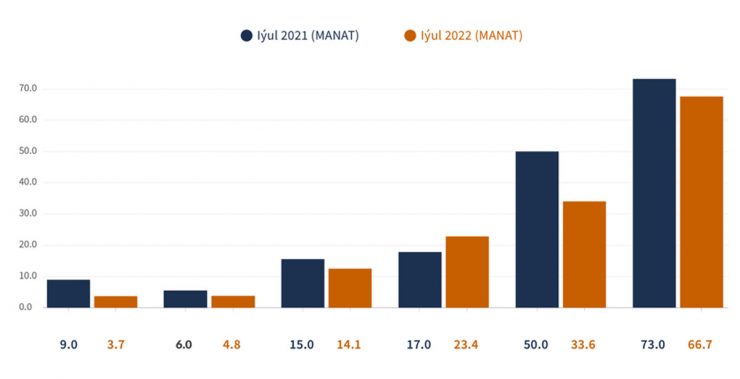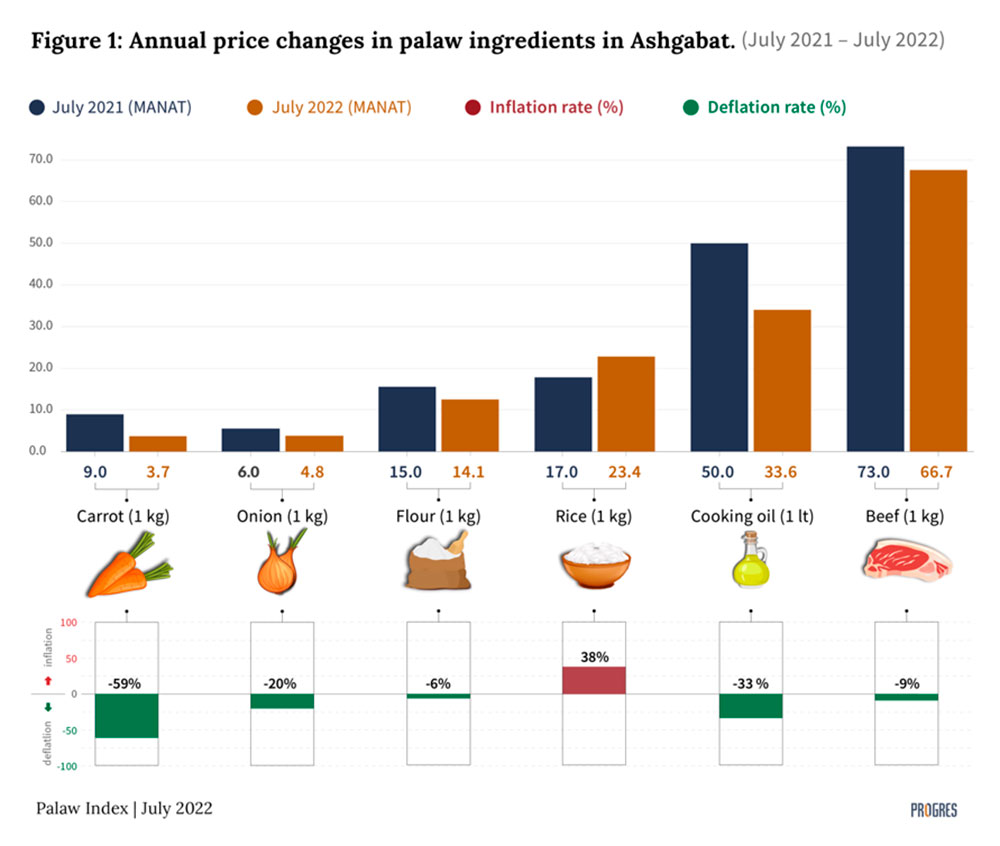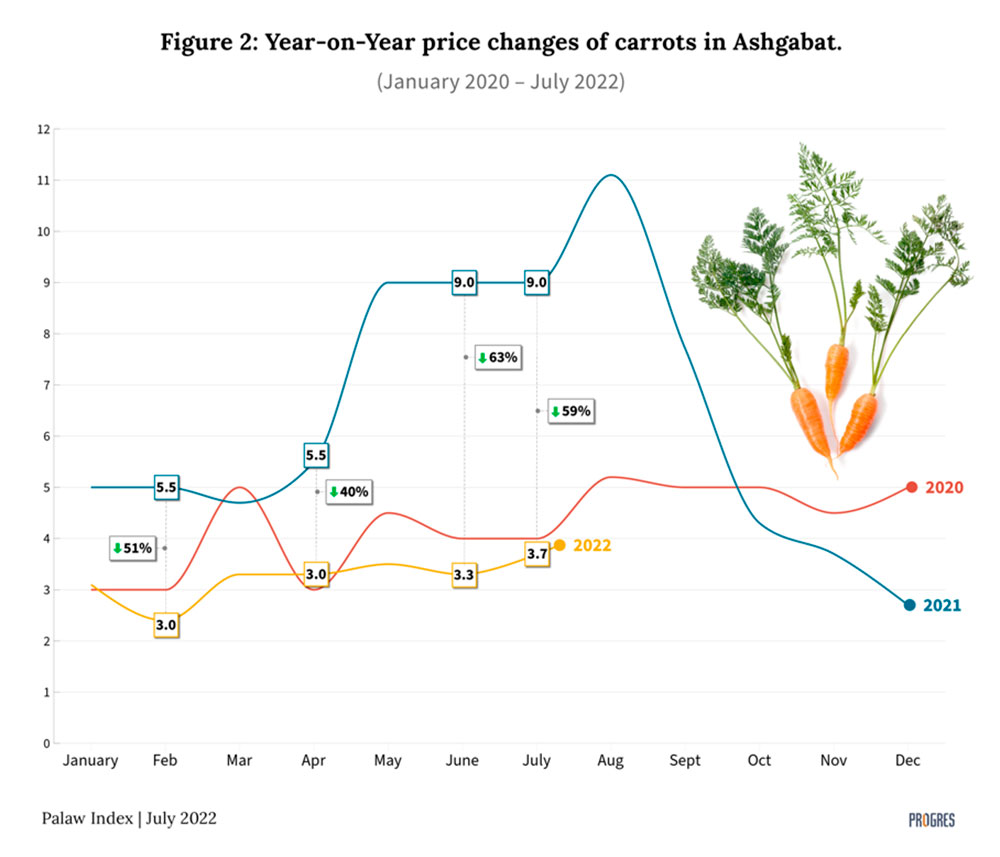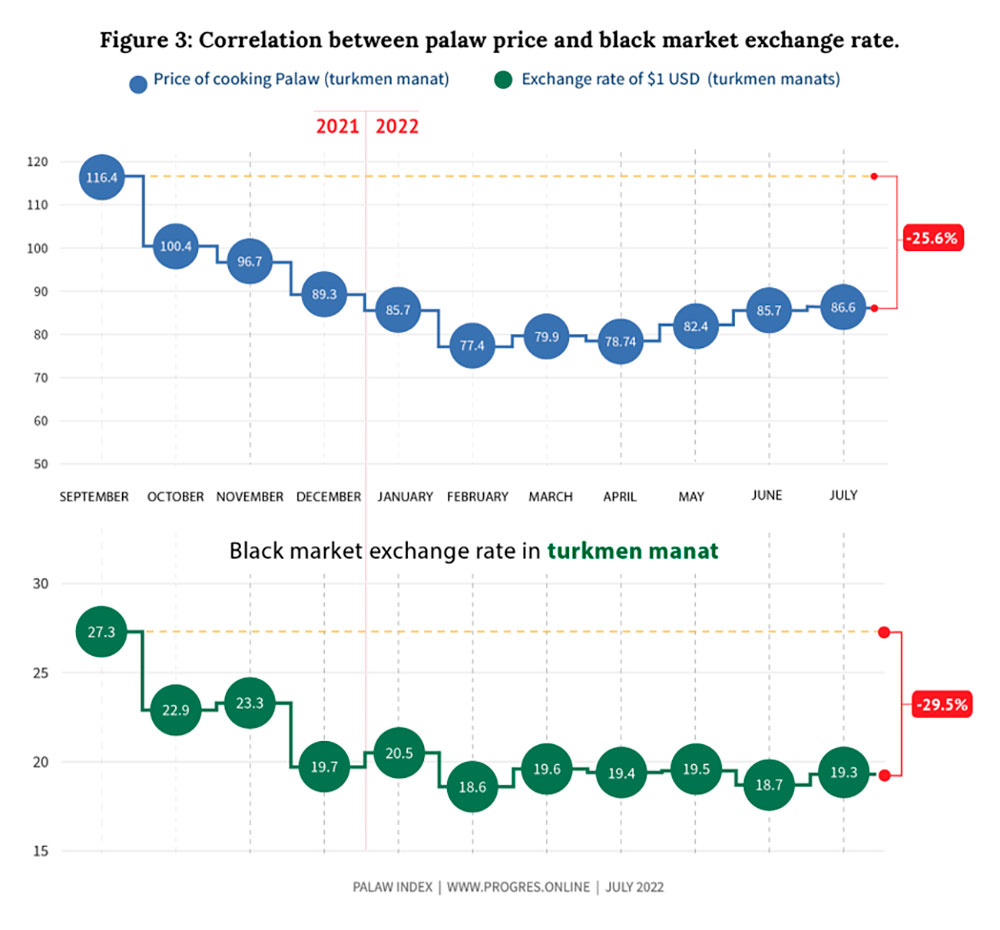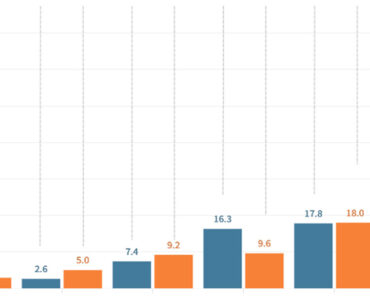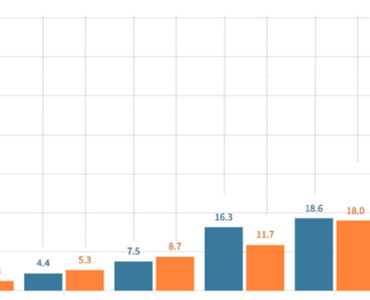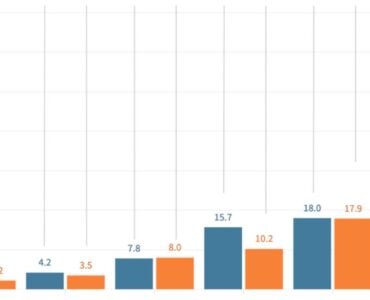July 2022: The cost of palaw drops for the second month in a row.
The average cost of cooking palaw in Ashgabat was 86.6 Turkmen manat in July 2022, which is 1.1% more expensive month-on-month (MoM) compared to June 2022 (85.7 manat) and 9.1% cheaper year-on-year (YoY) compared to July 2021 (95.3 manat). This is the second time in a row, when palaw prices decline based on YoY after dropping by 13.4% in June 2022. First time Palaw Index declined in April 2022 by 14.2%, while registering price increases in the remaining months of 2022 (January, February, March, and May).
Similar to the trends of the last month in June 2022, prices of all palaw ingredients except for rice have dropped in July 2022 on a YoY basis. Prices of carrots (-59%), sunflower oil (-33%), onions (-20%), beef (-9%) and wheat flour (-6%) declined YoY in July 2022 compared to the similar period in 2021. Prices of rice have risen by 38% over the same period of time (see Figure 1).
Why did the prices of carrots decrease so much?
Carrot prices decreased by 59% YoY in July 2022 compared to the same period last year (July 2021). Carrot prices also dropped by 63% in June 2022 YoY, 40% in April 2022, 30% in March, and 51% in February. We can see that carrot prices have been going down significantly in 2022 compared to similar months in 2021. We have checked the average prices of carrots sold in Ashgabat over the past three years and we have observed that carrot prices were unusually high in 2021, compared to their prices in 2020 or 2022. You can check the monthly prices of carrots from January 2020 to July 2022 in the figure 2 below.
As you can see in the figure, carrot prices were really expensive in 2021, especially from May to September 2021. So, the main question is not why carrots are becoming cheaper in 2022 but why their price was so high in 2021 in the first place. Carrot prices were somewhat similar in 2020 and 2022. So, 2021 is clearly an outlier. Therefore, we will try to analyze the reasons behind the price hikes of carrots in 2021.
We propose three possible explanations for that:
- Carrot production was low in 2021 compared to previous years due to unexpected circumstances (e.g, drought, lack of water, etc.)
Carrots are normally sown in early summer after the wheat harvest and harvested in late autumn. Carrots can also grow in greenhouses throughout the winter and are harvested in spring. According to the data from FAO, the production of carrots in Turkmenistan is only available until 2020 and there is no data for 2021 and 2022. Carrot production in 2020 was 71,650 tons and over the last 10 years, the volume of production has been hovering around 70,000 tons per year. The government of Turkmenistan does not publish carrot production on annual basis.
One possible explanation is that climate change induced stresses, such as drought, soil salinization, and low temperature of the weather, are the main factors that restrict the growth and development of carrots. In May, June, and July of 2021, the country experienced record-breaking temperatures. On 30 May 2021, the temperature in Ashgabat reached 44.8 degrees Celsius, which was the highest for the month of May in the last 130 years, reports Meteojournal. The same story happened on June 5 2021, when the city of Turkmenabat had the highest temperatures of 45.1 degrees since 1894. On July 5, some parts of the country (in Sarahs) reached 48.2 degrees, which was also the highest since 1894. Therefore, droughts as a result of high temperatures might have caused lower production of carrots, which in return, could increase their price. We have to remind the readers that the given temperatures are measured for individual days, and not the average ones for the whole months of May, June, and July in 2021. Nevertheless, even the average monthly temperatures were higher than in the previous years.
- Reduced volumes of carrot imports from Iran
Turkmenistan did not import carrots from the Eurasian Economic Union countries (Russia, Kazakhstan, Kyrgyzstan, Armenia, Belarus) in 2021. We know from the various reports that Turkmenistan mostly imports vegetables and fruits from neighboring Iran.
Turkmenistan closed its land and air borders with other countries since the beginning of the COVID pandemic in March 2020. Border terminals for cargo trucks and railways were also affected by the closure. For instance, Sarahs border terminal on the border with Iran was closed in March 2020 and fully reopened only in June 2022. Before that date, it was partially reopened for a reduced amount of transit. Railways crossing through that border were at 30% capacity only. Border terminals with Uzbekistan were also closed from March 2020 to November 2021. Basically, most border terminals were either closed or worked at a reduced capacity throughout 2021, which could potentially lower the import of carrots to Turkmenistan and increase its prices in that year.
Between August 23, 2021, to May 21, 2022, the value of non-oil exported products from Iran to Turkmenistan stood at 276.6 million USD, which is an 89% increase compared to the same period of last year. Among the main products exported from Iran to Turkmenistan were fresh fruits and vegetables. Although no specific number was given for the % increase in exports of carrots, we can safely assume that it was also affected by an apparent 89% increase in exports. Since exports of foodstuf by Iran to Turkmenistan were significantly lower in the first half of 2021, it can potentially explain the high prices of carrots sold in Turkmenistan in 2021.
- Due to the cheaper exchange rate
The value of manat against 1 USD in the black-market exchange rate averaged 32.9 manat last year in July 2021, while its value was 19.3 manat this year, in July 2022. This is a 41.3% decline over the one-year period. A higher exchange rate means more expensive imported carrots, as well as more expensive raw materials, inputs, and equipment used for the production of carrots. Hence, carrot prices were quite expensive in 2021 compared to a similar period in 2022.
What about monthly price changes of palaw?
On a monthly basis, prices of palaw ingredients have been decreasing steadily from 116.4 manat in September 2021 to 86.6 manat in July 2022, which is a 25.6% decline. When it comes to the black-market exchange rate of the manat/USD, it declined from 27.3 manat in September 2021 to 19.3 manat in July 2022, which is a 29.5% decrease (see Figure 3).
Methodology
Prices of ingredients in Palaw Index are collected for 1 kg of onion, carrot, beef, rice, and flour, and 1 liter of cooking oil. Based on the methodology, in order to cook palaw for a family of four, we use 0.3 liters of cooking oil, 0.5 kg of onion, 1 kg of carrots, 0.6 kg of beef, 1 kg of rice, and 0.5 kg of flour in our formula. Please click here to learn more about the methodology of Palaw Index.

